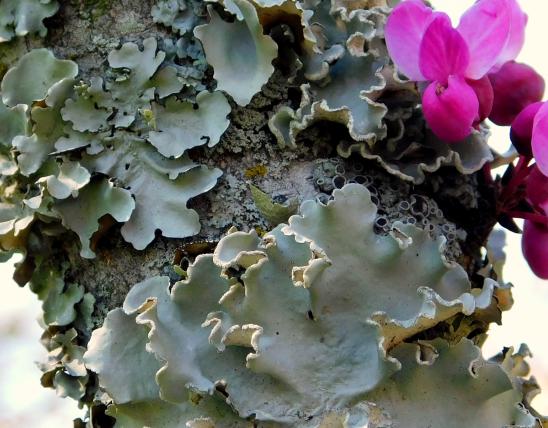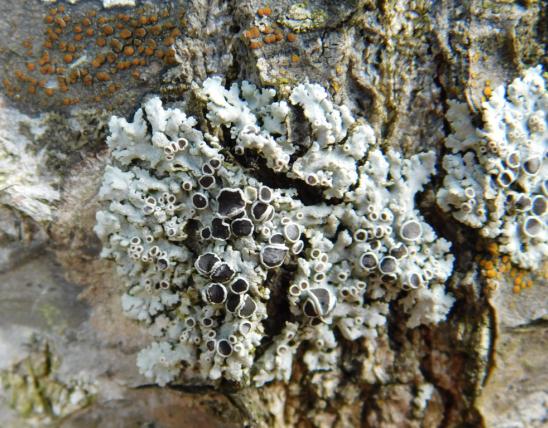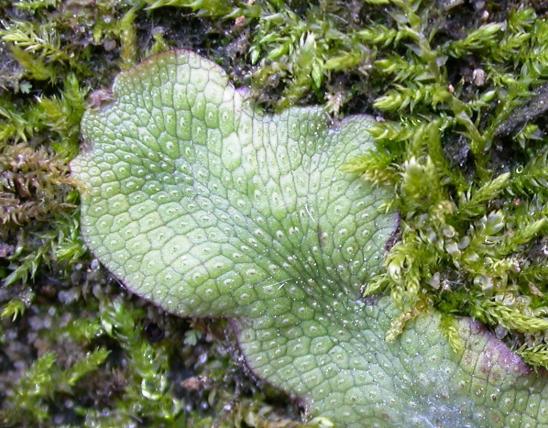
Dog tooth lichen (dog lichen, or felt lichen) is common and easy to identify. The thallus (main body) is rather large (to about 4 inches) and somewhat lobed (not usually looking very circular); the edges are ruffled and slightly upturning. Sometimes a narrow pale line is visible on the edge. The upper surface is variable, usually with a smooth, dull appearance. When dry, it’s gray or light brown and brittle. When wet, it is deep greenish brown, pliable, and rather leathery. The white or tan underside, with narrow, twisted, webby veins, makes it unmistakable. The apothecia (spore-bearing structures) are rusty brown and rolled, standing upright at the lobe tips.
Habitat is another key identifier: This lichen lives in moist, rich places, often on soil near decaying logs, or on seepy rock-face ledges where soil or mosses have accumulated.
Globally there are about 100 species in the genus, with 7 recorded for Missouri.
Dog tooth lichen, like other foliose lichens, generally looks lobed, frilly, or leafy, somewhat like foliage. Some foliose lichens look like tiny lettuce leaves. The lower surface of foliose lichens is usually a different color than the top surface.
A lichen is an organism that results when a fungus species and an algae species join together. Although the relationship between the fungi and algae is quite intimate and integrated, the lichen that is formed does not much resemble either of the components. Learn more about lichens on their group page.
Similar species:
- Globally there are about 100 species in genus Peltigera, with 7 recorded for Missouri.
- Another common group, called stippleback lichens, or rock tripes (Dermatocarpon spp.), are similar with their rather flopping-looking, gray bodies. But stippleback lichens cling to their substrate — almost always bluffs, boulders, and outcrops — by a single point of attachment. They typically grow in clusters, often lavishly. Each thallus is thin, pale gray or tan, brittle when dry but leathery when wet. Some species, when wet, become surprisingly bright green. Overall, the thallus is generally round, but the edges sometimes curl and split. The smooth, flat surface is always covered with tiny black dots: these are holes of the fruiting bodies, from which spores are released.
Lichens begin as tiny spots but may grow to cover several square inches. Groups of lichens may coalesce to cover rather large areas, several inches in length or diameter.
Statewide.
Habitat and Conservation
This species seems to prefer very moist habitats of soil or humus. One especially good place to find it is around a decaying log; dig through the leaves until you reach the moist humus at the base of the log where dog tooth lichen often grows against the wood. Another promising location for this lichen is on ledges of a seepy rock face where some soil or mosses have accumulated.
Status
This species can be common in the appropriate habitats. It is frequently overlooked.
Life Cycle
Dog tooth lichen has interesting, easy-to-see, distinctive apothecia (spore-bearing structures): They are brown, upright, rolled structures that arise from the lobe tips. As with other lichens, spores that are created in apothecia are a product only of the fungal partner of the lichen and do not include samples of algal cells. Therefore, a germinating spore must quickly partner with an appropriate algae species, or it will perish.
Human Connections
The name of this species is intriguing, and explanations vary. Some say that “dog lichen” comes from a history of this lichen being used as a treatment for rabies (which often afflicted dogs, before rabies vaccines were available). Others say that “dog tooth lichen” comes from the lichen’s upturned, tablike lobe tips — showing their white undersides — resembling the teeth of dogs.
This lichen is surprisingly common in Missouri woodlands. How many times have we seen it in the woods, growing near a damp, rotting log, and simply not recognized it for what it is? Nature is full of humble species whose abiding companionship we simply haven’t acknowledged yet.
Ecosystem Connections
Instead of green algae, this species has a blue-green alga (cyanobacterium) as its photosynthetic partner. That’s why it looks dark gray or greenish brown when it’s wet.
Dog tooth lichen, mosses, liverworts, and other lichens form miniature ecosystems on the forest floor, stabilizing the soil, collecting particles of organic debris, and providing a damp, shady habitat for numerous kinds of insects and other small animals.








Mosses, liverworts, hornworts, and lichens seem rather similar, but these organisms are in very different groups. Mosses, liverworts, and hornworts are small, low plants usually found in damp habitats. Unlike more familiar plants, they lack veinlike structures and do not produce flowers or seeds — instead, they produce spores. Meanwhile, lichens are not plants at all: they are a collection of different fungi that have photosynthetic algae living within their tissues.




























